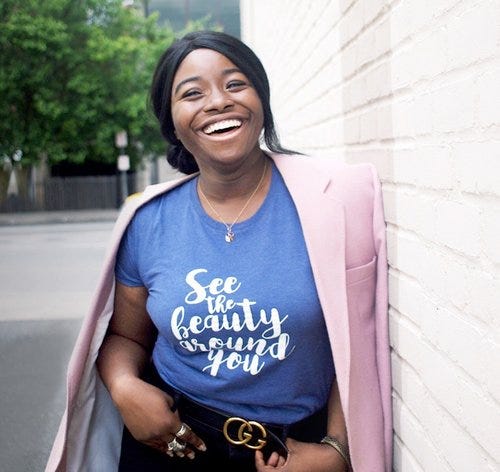Why We Need to Compete with the Status Quo (Instead of Each Other) with N. Chloé Nwangwu
“Your network matters. So you need to be cultivating and building it constantly. Because you can't be in every room. But your ideas can be.” - N. Chloé Nwangwu
N. Chloé Nwangwu is a delight. Not only is she an amateur hobbyist perfumer and the person I am always tipping my hat to for this language, she’s also positively wrecking our preconceived notions of personal brand methodology.
Given that her background involves negotiations between actual warring nations or factions, she is powerfully qualified to speak on the ways that under-recognized folks can use science to level the playing field and even out power dynamics.
This Q&A could never be enough to hold all of the magic in her brain, so I’ll let you read it AND direct you to a few other episodes I absolutely insist you listen to.
How to Be Seen Off Social Media – Visibility & Bias with N. Chloé Nwangwu (
)How to Become Impossible to Ignore With N. Chloé Nwangwu (
- thank you so much for introducing us in the first place!)A Brand is a Constellation with N. Chloé Nwangwu (
)
Okay, off you go into her brilliantness.
About N. Chloé Nwangwu
N. Chloé Nwangwu (known as The Brand Scientist) is the director of NobiWorks, a brand visibility consultancy for underrecognized social impact brands (including small online businesses, large non-profits and smaller democratic nations whose needs have been sidelined).
N. Chloé leverages behavioral science and her proprietary Visibility Engineering™ Method to make these brands impossible to ignore.
NobiWorks equips underrecognized brands with visibility strategies and systems scientifically formulated to help them neutralize visibility biases while commanding — and keeping— attention in an increasingly crowded marketplace.
She’s advised everyone from a small black, family owned mom and pop shop to the first refugee delegation to the UN.
Chloé’s clients have gone on to be better seen, heard, respected and resourced. That’s looked like celebrity endorsements, seats at previously inaccessible tables and hundreds of thousands of dollars.
N. Chloé lives in the US, where she wrestles with an addiction to D&D and tends to her giant baby Yoda plushie.
One of your pillar principles is that visibility is rarely about how hard you work. Rather, it’s about understanding how attention flows and recognizing the cognitive biases that result in an individual being seen or heard. What are a couple of those cognitive biases that impact underrecognized individuals?
I call the set of these cognitive biases, visibility biases. An excellent example is the Racial Attention Deficit. The researchers who discovered it empirically demonstrated that White Americans were 33% more likely to overlook their Black peers. Even when they’d been incentivized to pay attention to them.
Another example is something I call the Reciprocity Gap. Because we’ve been conditioned to expect the unpaid and unseen labor of underrecognized people, underrecognized folks tend to give more and get less in return than their peers. The rules of reciprocity are a bit warped for us. It’s the reason society wants to reward a father for making lunch for his rambunctious kids, while it has no such compunctions for a mother. She is just seen as “doing her job.” We see this Reciprocity Gap everywhere.
Because we’ve been conditioned to expect the unpaid and unseen labor of underrecognized people, underrecognized folks tend to give more and get less in return than their peers.
You’ve previously talked about how you can become influential without becoming an influencer. The primary way that you accomplish that is by choosing the right model of influence with the most appropriate scope, scale, and magnitude. Can you tell us more about each of those components and how they fit into which model of influence you choose?
Sure!
Each of these are a dimension of influence that I visualize as a spectrum. On the scope spectrum we have individual, group and structural. These are scopes of influence and they talk about what we are exerting influence on.
On the scale spectrum we have modest, moderate and mega. Your scale of influence helps us suss out the number of folks you are influencing directly.
And on the magnitude spectrum we have local, domestic and global. The magnitude of your influence talks about the number of folks you are ultimately influencing.
Your model of influence is the best fit for you and your goals across these three spectrums.
So for example, there is a model of influence with a group scope of influence, a modest scale of influence and a global magnitude of influence. That particular model lends itself quite well to being influential without being an influencer.
If you were looking to be an influencer, your model of influence would have a larger scale of influence. Probably Mega, but at least moderate.
One frustrating element of online business is the perceived need to join a pricey mastermind so that you can rub elbows with our industry’s tastemakers and influencers. Based on what I know about your work, I know you have other strategies to help people make those connections without heavy investment into a coaching program. Would you be willing to share one of them?
Totally.
So the thing that these pricey masterminds allow us to do is to cut out the work of establishing our own network. And sure, that can be helpful, but at the end of the day, it’s more sustainable, and safer to have our own. So that’s what I suggest. When I’m working with clients, one of the foundational things we work together to do is to set up or refine what I call a Circle of Recognition.
A circle of recognition is just a network, but it’s a network structured around a specific behavior – recognition – and designed to amplify your ideas and work in ways that inspire behavior change.
We usually start with a Stakeholder Starter Pack, which I talk more about here.
And then we map out their network. Literally.
Because chances are insanely high that you know someone who knows someone. So map out your network, with each of the stakeholder types (mentioned in the linked article) in mind and then start strategizing your way to the person or type of people you’re hoping to connect with.
And understand that if you’re underrecognized, or there’s a huge power differential between you and the stakeholder – or both – then reaching out directly, yourself, may not work right away. But that map will let you know who can casually mention you here, offer to make an introduction there and so on and so forth.
The map makes all of this so much easier and more straightforward.
It sounds simple, but all of the huge opportunities that have come my way and my client’s ways have all happened because of this approach – well, until folks started sending invitations themselves.
Our work has so much complementary overlap, and a piece that’s right in alignment is the belief that we should focus on being “distinct” rather than “differentiating” ourselves. But you take the idea one step further than I do. You talk about how our competition doesn’t need to be each other. Instead, we need to focus on the status quo as our competition. Tell us more about this juicy idea.
Oooh, yes.
So my issue with the focus on differentiation – well one of my issues haha – is the fact that it assumes the audience’s frame of reference.
When you’re trying to differentiate, you’re looking to be different from your peers. But your peers according to whom? Usually it’s us, the expert in question. We look at the market ecosystem and see a lot of other folks doing similar things. And so it seems obvious to say, “Ah, I need to be different from them.”
The thing is, our intended audience doesn’t have an expert’s frame of reference. So to them, your peer might be a tool they’ve put together themselves, a service from a completely different industry or, as is often the case, doing nothing at all.
Worse yet, the focus on differentiation makes our peers the enemy. After all, when we ask ourselves how we can be different from others, in order to have business success, we automatically put ourselves in competition with them.
Instead, compete with the status quo.
If you have values that seem like they’re at odds with the way things currently are, and those values guide the work you do with clients or other stakeholders, then the status quo is likely also something you are looking to shift or even vanquish.
You likely have a vision for the future.
You likely intend for that future to replace the nightmare the status quo has dreamed up for us.
So, uh, go ahead then. Fight. Win.
Rather than fighting for a degree of difference from peers your intended audience may not even be aware of, wouldn’t it make more sense to own an influential idea they intuitively understand would make a difference in their status quo?
That’s what it means to be distinct, really. Be easy to remember and easy to identify. Be the right kind of memorable.
And all doing that requires is a shift in our frame of reference from our own to our audience’s.
What’s in your TBR pile right now?
Oh my gosh, there are SO many research papers haha.
But outside of that, there’s a scifi book, A Desolation Called Peace that I cannot wait to get my hands on. Then there’s Rebecca Roanhorse’s The Mirrored Heavens, which I haven’t yet gotten the chance to read. And then the sequel to this incredible work by Micaiah Johnson called The Space Between Worlds. I LOVED that book and need to get around to the sequel.
This newsletter is called Doing It for the Attention. What aspect of your business do you want us to pay attention to? In other words, how can we support you?
What a great question! So, I’d love it if folks would check out my newest Assessment. My research has pinpointed 5 stages of visibility and this assessment tells you which one you’re currently in!
Have questions for N. Chloé? Subscribe to her newsletter or attend one of her free Visibility Clinics.





